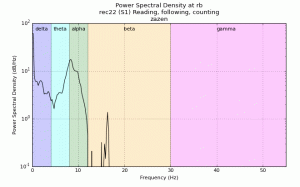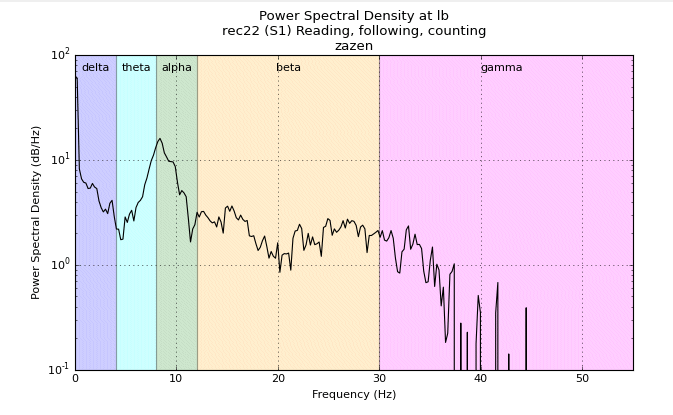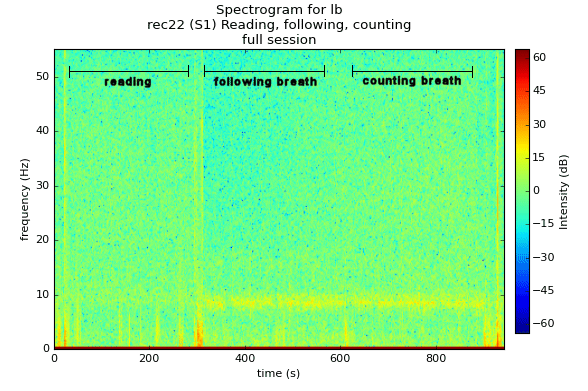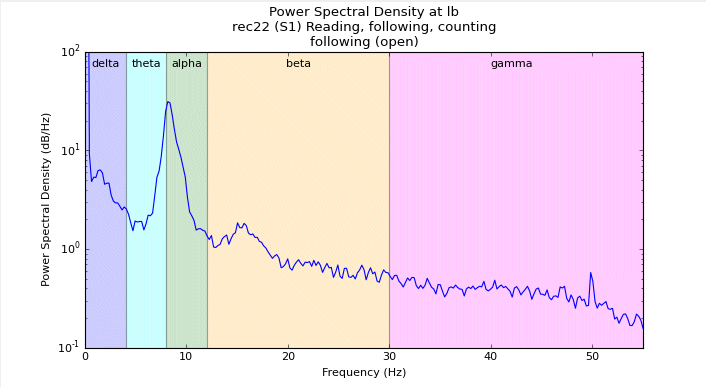Alpha waves are generally defined as neural oscillations in the range of 7.5 Hz to 12.5 Hz. They represent the strongest electrical signals on the scalp and were first discovered by German neurologist Hans Berger in 1924). Alpha waves originate in the occipital lobe (back of the head). They are especially prominent during a state of relaxation with the eyes closed.
Due to their characteristically high power, alpha waves are the easiest EEG signals to pick up.
In order to determine the precise frequency of alpha waves as well as other neural oscillations, we implemented Power Spectral Distribution (PSD) graphs. These graphs plot the spectrum of a given EEG signal, i.e., the intensity of the signal (Db/Hz) vs. its frequency (Hz). The y-axis is logarithmic with a range from 0.1 to 100 and the x-axis is linear in frequency.
The example below shows the spectrum of the signal from the left back sensor (TP9) during a four-minute period of zazen (counting the breath).
The tip of the most pronounced peak falls at 8.18 Hz, at the bottom end of the alpha band.
The alpha peak is apparent in all four sensors, most prominently in the left back (TP9) sensor but also in the right back (TP10), and the sensors left front (FP1) and right front (FP2), as seen below.
 |
 |
 |
 |
Note that the alpha rhythm is stronger in the region near the ears (lb, rb) than in the front (lf, rf).
For a single individual (myself) over a period of twelve months, this peak has been stable during zazen practice. Across 34 sessions, the mean frequency has been 8.2 Hz with a standard deviation of 0.2 Hz.
In recordings of other people, the same peak can be seen, but at slightly different frequencies. The alpha band feature is quite robust: it seems to occur in most people, especially if they are relaxing. It occurs reliably when a person’s eyes are closed, and can also occur with eyes open as long as the eyes are relatively still and not moving about.
Among 11 different individuals of wide-ranging meditation experience, the range of the alpha peak was from 8.1 Hz to 11.0 Hz. The mean frequency was determined to be 9.4 Hz with a standard deviation of 0.8 Hz. Thus the spread of the alpha peak frequencies across different individuals is over four times as wide (0.8 Hz vs. 0.2 Hz) as the spread of frequencies for a single individual.
Returning to the original recording of one individual, we see segments for three separate conditions: reading, following the breath, and counting the breath (eyes open for all three segments). Below is a spectrogram of the full session.
The alpha power is stronger during meditation (following or counting the breath) than it is during reading. This is indicated by the strong horizontal yellow line at frequency 8 Hz for the meditation conditions and its near absence during reading.
The PSD charts for each of these three intervals, measured at the left back (lb) sensor provides more detail on the predominate frequencies.
Values for alpha peaks are reading: 4 dB/Hz; following (eyes open): 32 dB/Hz and counting (eyes open): 40 dB/Hz.
A strong alpha peak is not necessarily a signature of meditation, but reading definitely suppresses the alpha oscillations compared to two kinds of meditation with eyes open.
Our next task will be to use Power Spectral Density graphs to examine other regions of the frequency spectrum, in delta, theta, beta and gamma bands.





[…] discussed in a previous post, alpha waves account for the most common frequency peak at around 8 Hz for individuals relaxed and […]